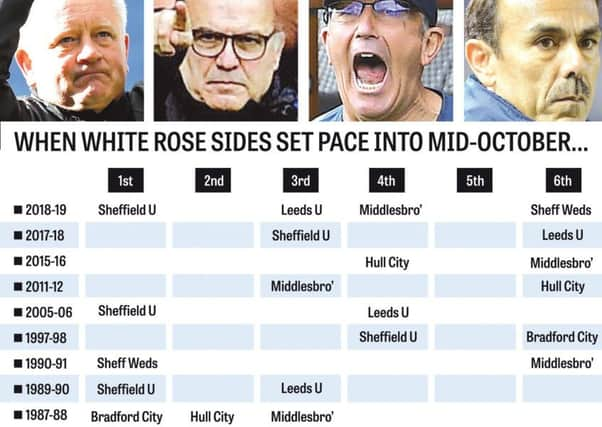Sheffield United, Leeds United, Middlesbrough and Sheffield Wednesday ensure we've never had it so good


Over the past three decades since the play-off system was introduced in 1986-87, early White Rose pacesetters have been fairly frequent in number, most spectacularly manifested by a Sheffield United side who recorded the best start to a Championship season with 27 points from a possible 30 to fly out of the traps at the start of 2005-06.
But to have four teams in the top six at the mid-October mark represents a veritable feast and is another noteworthy first.
Advertisement
Hide AdAdvertisement
Hide AdIt may be a time of year when the darker nights and shortening days leave many feeling decidedly cheerless, but the sight of the current Championship table should provide comfort to Blades, Leeds United, Middlesbrough and Sheffield Wednesday supporters, with their sides being all healthily placed in the top six after the opening quarter of the campaign.
Analysis of years gone by shows that while some Yorkshire sides have fallen away, plenty of others have lasted the course and the law of averages would surely suggest that at least one side from the Broad Acres will be celebrating come May.
In terms of history, you perhaps have to go way back to October, 1987 for the last time that the early table at this level looked so rosy for the county.
Then, Terry Dolan’s Bradford City led the way after a wonderful start to 1987-88, closely followed by second-placed Middlesbrough, continuing their remarkable rise from near-oblivion under Bruce Rioch. Completing the set in third were Brian Horton’s Hull City.
Advertisement
Hide AdAdvertisement
Hide AdUnfortunately for the Tigers, their only say in the promotion stakes in the Spring arrived on May 2, 1988 when Boothferry Park hosted Millwall’s title-winning party with Horton being sacked the previous month after Hull’s form nosedived spectacularly from their early-season highs. They finished 15th.
Bradford and Boro stuck around rather more impressively, but achieved notoriety after heartbreakingly missing out on automatic promotion after suffering home defeats to Ipswich Town and Leicester City on the final day of the 1987-88 season – with Aston Villa slipping in through the back door as runners-up to Millwall.
There was redemption at least for Boro, who saw off the Bantams in an all-Yorkshire play-off semi-final en route to a second successive promotion.
In terms of sustaining early-season form all the way through and securing a top-two finish without the need to enter into the dreaded end-of-season play-off lottery, Leeds and the Blades most famously proved the embodiment of consistency in a memorable automatic promotion double for Yorkshire two seasons later in 1989-90.
Advertisement
Hide AdAdvertisement
Hide AdIt will serve as motivation in the pair’s current quest, although the sight of the Blades and the Whites in the business positions of the division in mid-autumn is nothing new.
Both could not sustain strong openings last season, but displayed rather more longevity in 2005-06 – just as they did at the start of the 90s.
Pride of place went to the Blades – then managed by serial promotion fixer Neil Warnock – who accompanied Reading to the top flight. By contrast, Kevin Blackwell’s Leeds secured a top-six finish, only to lose out in the play-off final to Watford in 2006.
Similar nerve to that displayed by the Blades was shown by Ron Atkinson’s Sheffield Wednesday in 1990-91 when the Owls – who topped the old Division Two league table at the quarter-season mark – claimed the final automatic promotion slot to crown a vintage campaign.
Advertisement
Hide AdAdvertisement
Hide AdThe Owls’ feats were made all the more laudable by the fact that their promotion crusade was not derailed by their stellar success in beating Manchester United in the League Cup final at Wembley that season, when they became the first team outside of the top flight to win the competition since 1969 when Swindon Town defeated Arsenal.
Juggling league and cup commitments also famously proved no bugbear to Wednesday in 1983-84, when Howard Wilkinson’s durable side – who prided themselves on their organisation and fitness – returned the club to the big-time after finishing Division Two runners-ups to Chelsea and also reached the last eight of the FA Cup and League Cup.
In more recent times, the endurance levels of Boro and Hull were showcased in 2015-16.
Both were in the top six in mid-October of that season and went on to be promoted.
Advertisement
Hide AdAdvertisement
Hide AdBut while several Yorkshire sides have shown the requisite fortitude and backbone to stay strong over the nine-month marathon, other ‘early-risers’ have not been fortunate.
Alongside Hull’s dramatic slump after hitting some autumn heights in 87-88, Middlesbrough’s chalk-and-cheese campaign in 2011-12 showcased another major fall from grace.
Tony Mowbray’s side were flying high in third place in October, 2011, with Steve Bruce’s Tigers in fifth.
Come season’s end, Hull were confirmed as runners-up, while Boro finished way down in 16th position after a desperate second-half of the campaign with Mowbray eventually leaving his boyhood club early in the following season.
That, more than anything, provides conclusive proof that ultimately it is not about how you start, but how you finish.